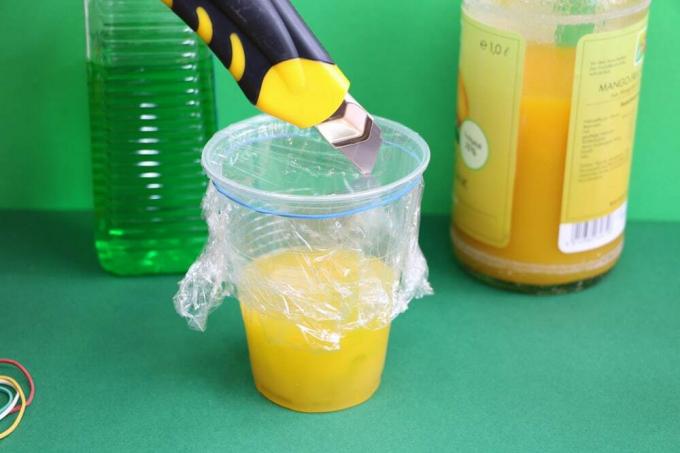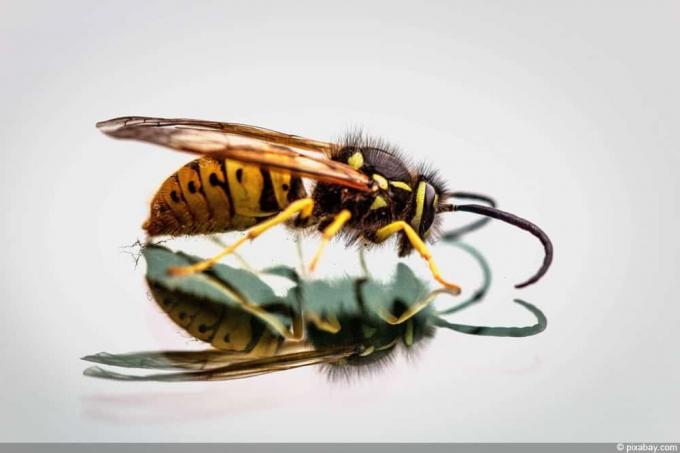

Table of contents
- prevention
- animal feed
- free air
- fragrances
- fall
- sticky traps
- liquid traps
- Frequently Asked Questions
- Worth knowing about fly traps shortly
When the fly swatter can no longer get the situation under control, many pull out the chemical club. However, such agents are not only expensive and harmful to the health of humans and pets, they can also cause resistance in some insects and thus become ineffective.
Combating and preventing flies and fruit flies biologically, on the other hand, has several advantages. Biological fly control is therefore inexpensive, harmless to health and also gentler on the environment. With the right means and measures, however, effectively.
prevention
As so often in life, the same applies to flies and fruit flies: prevention is better than cure. It is therefore better than fighting the annoying insects not to let them into the house in the first place. To do this, it is first important to know their preferred food sources.
They are attracted to:
- food and drink leftovers
- fruit and vegetables
- Garbage
- compost
- used litter boxes and other animal feces
animal feed
In order not to attract the insects in the first place, you should pay attention to a few factors, especially in the warm seasons.
- appropriate storage of the food
- It is better to store fruit and vegetables in the refrigerator
- Food, drinks and leftovers should not be left outside
- It is best to wash dishes immediately after use and wipe off soiled surfaces
- Wash out beverage bottles or close them tightly
- do not leave any animal feed
- Clean pet toilets and cages frequently
- Remove rubbish from outside the home immediately
- wash out the trash can
- Close trash bags tightly
- If at all possible, keep garbage cans away from the house
Nevertheless, it may become necessary to control flies and fruit flies biologically. Because the measures mentioned reduce the risk of a plague, but the pests can still be found in the apartment. Fruit flies are usually brought in together with fruits and vegetables, house flies can definitely 'fly away'. But even then they can be stopped.
free air
Flies and fruit flies like warmth and stale air that smells of food and, in their case, like garbage or feces. Another important preventive measure is therefore frequent and regular airing. However, open windows are also an invitation to the winged insects. There are a few things to keep in mind when opening the windows.
So you should only ventilate when it's cool outside and the windows are in the shade. This not only prevents mold growth, but flies are also less active at this point. Of course, this is not always possible, especially in summer. In addition, windows and balcony doors must therefore be provided with fly screens or curtains. In addition to flies, these also keep mosquitoes and moths away. Special versions even filter pollen out of the air, making them ideal for allergy sufferers.
Tip:
Check the nets regularly for damage and holes and replace them if necessary, only then can they do their job.
fragrances

As much as flies and fruit flies prefer some scents, they are deterred by others. Anyone who knows these can fight flies and fruit flies biologically and at the same time do something good for your own nose. Act as a deterrent to insects:
- mint
- lavender
- laurel
- tomatoes
- basil
- geraniums
- cloves
Fresh, dried or applied as an oil, the aromas mentioned are ideal for making the balcony, window and apartment less attractive to the pests.
Tip:
This measure can be carried out particularly quickly and with little effort if the substances are placed on cloths in the form of essential oils and these are placed on the windowsill.
fall
If all else fails and flies and fruit flies keep popping up in the house despite the utmost caution and thoroughness, traps are the method of choice. Basically, sticky traps and liquid traps can be distinguished here.
sticky traps
Sticky traps, such as rolled up flypaper, are inexpensive and quick to install. The roll is hung up and then easily pulled out of the packaging. The sticky coating ensures that the flies cannot get away from it and die comparatively quickly in the trap. When the flypaper is full, it is thrown away. However, such traps do not only have advantages. Everything sticks to them, including hair, pets and beneficial insects. So they have to be out of reach, which is often not easy with cats or birds flying freely in the room, for example. On the other hand, they are not very attractive and put an ugly end on the flies.
liquid traps
The liquid traps are suitable for biological control of both flies and fruit flies. Depending on the exact type, they are more effective for some than for others. A quick version is to mix vinegar, fruit juice or syrup with a little water and one to three drops of dishwashing liquid and set it aside. The smell attracts flies, the lack of surface tension caused by the dishwashing liquid leads to drowning in the liquid. Fruit flies in particular are quickly identified with it.

A mixture of plenty of sweetener, but not stevia, and sugar water or fruit juice is a little more effective for house flies. The flies do not drown in it, but are poisoned by the liquid. Unfortunately, they still get a little way and usually don't land directly in the trap, which in turn requires cleaning. The classic fly agaric trap, from which the fly agaric got its name, works in a similar way. A mushroom is cut into small pieces and warm milk is poured over it. After about a day, the milk is infused with the mushroom's poison and quickly kills the flies. However, there is a risk that pets could also be poisoned.
Frequently Asked Questions
Yes. With blotting paper, syrup and pepper. The paper is coated with a mixture of pepper and syrup and then works like commercial fly paper. However, the associated effort and the difficulty of attachment are hardly worth it due to the low prices for finished flypaper.
No. There are simply more flies in rural areas in particular because animal husbandry gives them better chances here. If the pests are found outside in large numbers, they also end up in the house more often. Thorough grooming and eliminating potential food sources will help keep them from over-dressing.
Worth knowing about fly traps shortly
As soon as the temperatures rise, the chance that you will inevitably encounter flies in the house and garden increases. They are almost always a nuisance when food is involved. The only way to get rid of flies is to use a combination of fly repellent and fly traps - depending on where you want to use them.
- If you want to avoid flies in the house, you should first use a fly screen to repel flies.
- A curtain is suitable for doors, e.g. B. made of bamboo. This does not have to be tight. It is already sufficient if the door is draped over a large area.
If flies do get into the apartment, you can fight them with various fly traps:
- The most well-known fly trap consists of a combination of glue and a sweet compound that attracts flies with its smell. These fly traps are already available from approx. 2 euros per 4 pieces and they are very effective especially on fruit flies.
- There are suns and stars on the market that you can stick to the window. These motifs are wetted on the surface with a substance that is deadly for flies, so that the flies die within a short time after touching the flytrap.
Notice
However, whether this is to be recommended without reservation, especially if there are children in the house, is to be questioned! - A household remedy that is particularly suitable for barbecues is fly paper. This flytrap can be made as follows: Take ground pepper and syrup; mix this to a pulp and soak a piece of blotting paper in it. This is placed on the ground a few meters from the terrace and you can soon see how the flies are attracted to the biological fly trap.
 garden editorial
garden editorial I write about everything that interests me in my garden.
Learn more about insect repellent

Can grasshoppers/hay horses sting or bite?
When grasshoppers or hay horses appear frequently in the garden, on meadows and fields during the warm season, many questions arise. Especially when children want to catch them, is it important, for example, whether they can sting or bite? We clarify.

Tick nest in the garden: how to recognize it
A tick nest can appear in certain spots in the garden that have a suitable microclimate. It can be recognized by its typical coloring. Because the hatching larvae are mobile, the nest quickly develops into a collection of tiny bloodsuckers.

Make your own flycatcher | 15 home remedies for fly baits
Clever home gardeners simply make fly catchers themselves. This saves money, guarantees non-toxic ingredients and allows decorative design options. Self-made fly traps do not necessarily mean the death sentence for the summer tormentors. Read here practical instructions with 15 proven home remedies for effective insect catchers.

How long does wasp venom stay in the body? Information on wasp poison and effects
A wasp sting is pure horror for many people. Although it does not necessarily have to be bad, it is often more painful than a bee sting. The reason for this is the composition of the wasp venom. More about its effects and its dangers can be found here.

15 native wasp species | 8 of them don't sting
In Germany there are only a dozen colony wasp species. The vast majority lives solitarily above and below ground. Get to know 15 native wasp species with distinctive distinguishing features. Not all of them act as annoying calf biters. These 8 types of wasps don't sting.

Wasp stings in dogs: first aid for stings in the mouth and paw
If the dog has been bitten by a wasp in the mouth or paw, then help should be provided quickly. Although the stings are not usually dangerous, the animal does not know why it is in pain and should be weaned as soon as possible.

